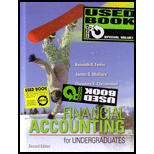
1)
Calculate the company’s return on sales ratio for 2009, 2010, and 2011. Explain the return on sales trend.
1)
Explanation of Solution
Return on sales ratio: The ratio which evaluates the amount of net income earned for every dollar of net sales is referred to as return on sales ratio.
Compute the return on sales ratio for Incorporation G for the year 2009.
Net income = $1,304.4 million
Net sales = $14,555.8 million
Compute the return on sales ratio for Incorporation G for the year 2010.
Net income = $1,530.5 million
Net sales = $14,635.6 million
Compute the return on sales ratio for Incorporation G for the year 2011.
Net income = $1,798.3 million
Net sales = $14,880.2 million
Trends:
- Profitability of Incorporation G is measured by return on sales ratio.
- The ratio is has increased from 8.96% in 2009 to 10.4% in 2010 to 12.1% in 2011.
- This shows that the company’s profitability has increased.
2)
Calculate the company’s
2)
Explanation of Solution
Current ratio: Current ratio is one of the
Compute current asset ratio for Incorporation G for the year 2010.
Current assets = $3,480.0 million
Current liabilities = $3,769.1 million
Compute current asset ratio for Incorporation G for the year 2011.
Current assets = $3,902.0 million
Current liabilities = $3,659.2 million
Trends:
- Liquidity of Incorporation G is evaluated by current ratio.
- The ratio shows an increasing trend from 0.92 in 2010 to 1.1 in 2011.
- This shows that the capacity to pay for short-term liabilities has increased.
3)
Calculate the Company’s debt-to-total-assets ratio for 2010 and 2011. Explain the trend in debt-to-total-assets ratio.
3)
Explanation of Solution
Compute debt-to-total-assets ratio for Incorporation G for the year 2010.
Total assets = $17,678.9 million
Total liabilities = $12,030.9 million
Compute debt-to-total-assets ratio for Incorporation G for the year 2011.
Total assets = $18,674.5 million
Total liabilities = $12,062.3 million
Trends:
- Liquidity of Incorporation G is measured by debt-to-total-assets ratio.
- The ratio shows a decreasing trend from 68% in 2010 to 65% in 2011.
- This shows that the repaying capacity of the corporation has increased.
4)
Calculate the Company’s
4)
Explanation of Solution
Free cash flow: Free cash flow describes the net cash provided from operating activities after making required adjustments for capital expenditures. In other words, it is the cash flow arrived after making payment for capital expenditures.
| Particulars | 2009 | 2010 | 2011 |
| Free cash flows: | |||
| Cash flow from operating activities | $1,828.2 | $2,181.2 | $1,526.8 |
| Less: Cash investment in property, plant and equipment | 562.6 | 649.9 | 648.8 |
| Free cash flow | $1,265.6 | $1,531.3 | $878.0 |
Table (1)
Trends:
- The ratio shows a mixed trend from 2009 to 2011.
- Incorporation G had a healthy free cash flow in the years to repay its lenders, pay dividends to stockholders.
Want to see more full solutions like this?
Chapter 4 Solutions
Financial Accounting for Undergraduates
- Reffering to fair value of an asset, division, or organization, What exactly is fair value and how is it assessed?arrow_forwardThe following transactions involving intangible assets of Oriole Corporation occurred on or near December 31, 2025. 1.) Oriole paid Grand Company $520,000 for the exclusive right to market a particular product, using the Grand name and logo in promotional material. The franchise runs for as long as Oriole is in business. 2.) Oriole spent $654,000 developing a new manufacturing process. It has applied for a patent, and it believes that its application will be successful. 3.) In January 2026, Oriole's application for a patent (#2 above) was granted. Legal and registration costs incurred were $247,800. The patent runs for 20 years. The manufacturing process will be useful to Oriole for 10 years. 4.) Oriole incurred $168,000 in successfully defending one of its patents in an infringement suit. The patent expires during December 2029. Oriole incurred 5.) $446,400 in an unsuccessful patent defense. As a result of the adverse verdict, the patent, with a remaining unamortized cost of…arrow_forwardNonearrow_forward
- I need help solving this general accounting question with the proper methodology.arrow_forwardI need help with this general accounting question using the proper accounting approach.arrow_forwardPlease provide the correct answer to this general accounting problem using valid calculations.arrow_forward
- Can you explain the correct methodology to solve this general accounting problem?arrow_forwardCan you solve this general accounting question with the appropriate accounting analysis techniques?arrow_forwardCan you solve this general accounting problem using appropriate accounting principles?arrow_forward

 AccountingAccountingISBN:9781337272094Author:WARREN, Carl S., Reeve, James M., Duchac, Jonathan E.Publisher:Cengage Learning,
AccountingAccountingISBN:9781337272094Author:WARREN, Carl S., Reeve, James M., Duchac, Jonathan E.Publisher:Cengage Learning, Accounting Information SystemsAccountingISBN:9781337619202Author:Hall, James A.Publisher:Cengage Learning,
Accounting Information SystemsAccountingISBN:9781337619202Author:Hall, James A.Publisher:Cengage Learning, Horngren's Cost Accounting: A Managerial Emphasis...AccountingISBN:9780134475585Author:Srikant M. Datar, Madhav V. RajanPublisher:PEARSON
Horngren's Cost Accounting: A Managerial Emphasis...AccountingISBN:9780134475585Author:Srikant M. Datar, Madhav V. RajanPublisher:PEARSON Intermediate AccountingAccountingISBN:9781259722660Author:J. David Spiceland, Mark W. Nelson, Wayne M ThomasPublisher:McGraw-Hill Education
Intermediate AccountingAccountingISBN:9781259722660Author:J. David Spiceland, Mark W. Nelson, Wayne M ThomasPublisher:McGraw-Hill Education Financial and Managerial AccountingAccountingISBN:9781259726705Author:John J Wild, Ken W. Shaw, Barbara Chiappetta Fundamental Accounting PrinciplesPublisher:McGraw-Hill Education
Financial and Managerial AccountingAccountingISBN:9781259726705Author:John J Wild, Ken W. Shaw, Barbara Chiappetta Fundamental Accounting PrinciplesPublisher:McGraw-Hill Education





